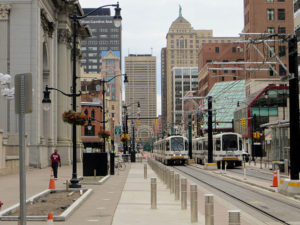
Buffalo Light Rail at Fountain Plaza by David Wilson from Oak Park, Illinois, CC BY 2.0
Bruce Fisher is a great analyst on Rust Belt cities. Because he focused on Buffalo specifically, his work isn’t known as well as it should be because some of the observations are very relevant to many places.
For example, he has a new column out in the Daily Public looking at the impact of “legacy income” on Rust Belt cities and how that will dwindle over time.
Over the past 20 years, data from the Bureau of Economic Analysis show that the norm had been that 18 percent of all personal income here comes from federal and state government programs—including the Social Security that working people pay into all their working lives. But as of the latest available figures, that share has grown—to 22.6 percent. Here’s what that signals: New jobs don’t pay like pre-Great Recession jobs used to, and retirement income is more important than ever to the regional economy.
Pensions, disability, and Social Security comprise a fifth of personal income here. Another fifth comes from government jobs—mainly teachers, public safety personnel, and college professors, but also the broad range of civil servants, everybody from snowplow drivers to weather forecasters to road crews and school nurses.
This is what economists mean when they say we have a “mixed” economy. Private employment in the Buffalo-Niagara Falls metro accounts for at least 480,000 of the 580,000 or so jobs here. The private sector still accounts for an overwhelming share of the personal income of working people.
But as we’ve tracked for a bunch of years now (today’s analysis looks at numbers just released last month, current through the end of 2017), this region is living off its legacy as a manufacturing center. That legacy includes high-wage employment that no longer exists except in the form of private pensions.
…
The Buffalo economy of the industrial age is gone, except that its legacy continues to pay our collective bills. How? Through transfer payments, through private and also public pensions, and through the marvel of high ratios of discretionary, disposable income thanks to the low cost of housing here.That’s why Buffalo and other Rust Belt cities enjoy such a robust entertainment sector, as various national and major-market media seem to have discovered. Restaurateurs, cultural venues, and other market-conscious business types are wise to track the supply of elderly and near-elderly people here and in other places where big factories once pumped out retirees with nice pensions, and where public employment guarantees 20 percent of the workforce a very secure retirement. To widespread pension security add the phenomenon of the paid-off house, and voila: Even without an uptick of child-free, urban-trending millennials, the coffee shops, saloons, boutique eateries, fromageries, artisanal olive-oil shops, farmers’ markets, and middle-ticket restaurants continue to do good business.
Retiree money is critical to several sectors here, because for current workers, for the not-yet retired, there are tectonic shifts underway.
…
The gist: So long as there is a decent supply of elderly people bringing Social Security and Medicare benefits in to pay for healthcare workers (Medicare doesn’t go to the patient, but to the healthcare establishment), and so long as there is some steady pay for civil servants, the Western New York economy has a baseline of income stability.Let’s hope that the next round of General Motors plant closures bypasses Buffalo. And that Tesla’s 600 employees grow to the 3,000 Elon Musk promised. And that millennials and climate refugees begin the remigration to our shrinking (our population dropped by 30,000 since 2001) but cheerful and well-promoted region. They’ll find housing in oversupply, dysfunctional public transit, and politicians flush with Christmas cheer from real-estate developers both free and, like one of our congressmen, out on bail.
They’d best arrive soon, before our retirees die off and leave a huge hole in our regional economy.
Click through to read the whole thing.
from Aaron M. Renn
https://www.urbanophile.com/2018/12/21/dwindling-legacy-income-in-rust-belt-cities/
No comments:
Post a Comment